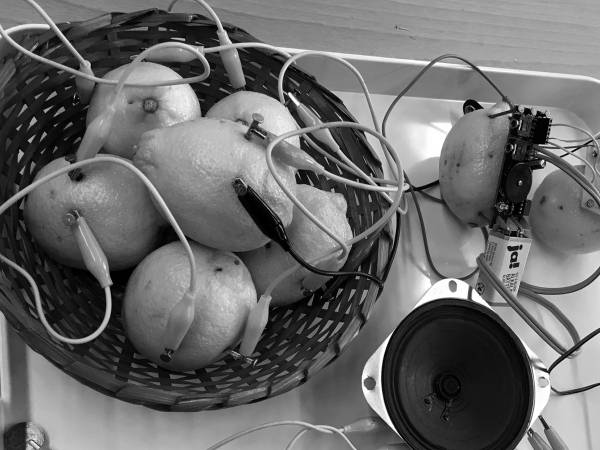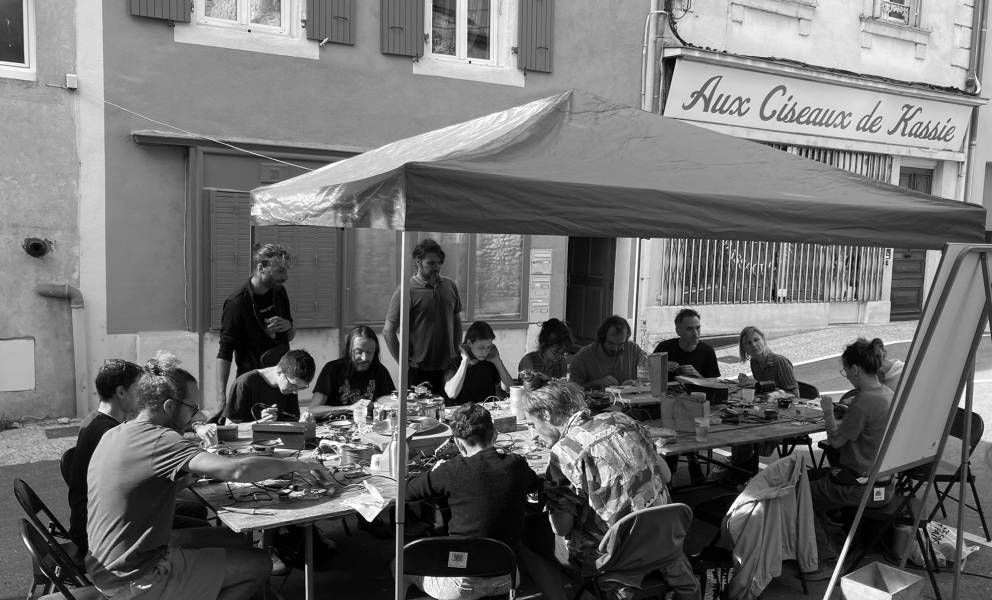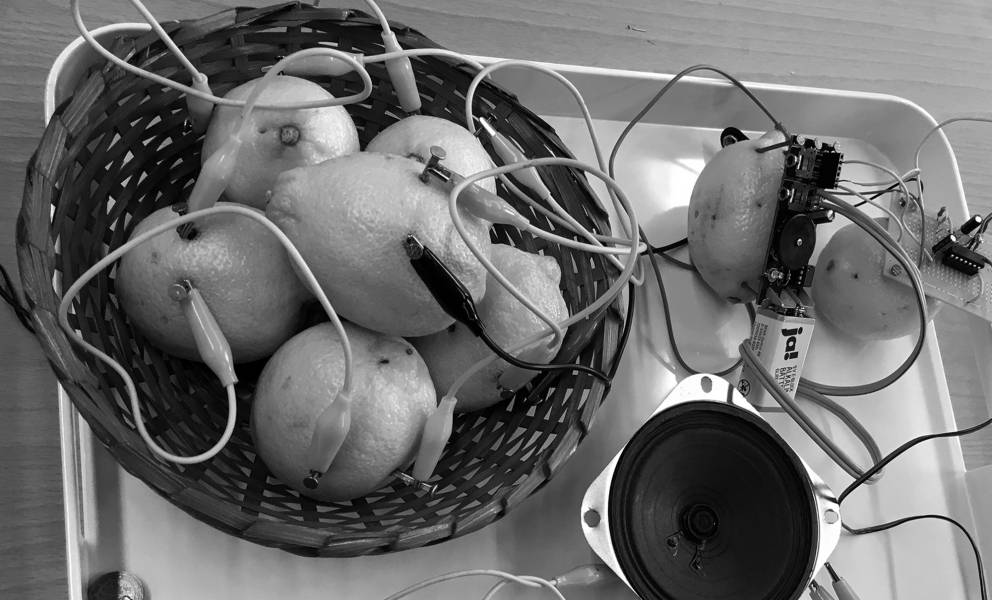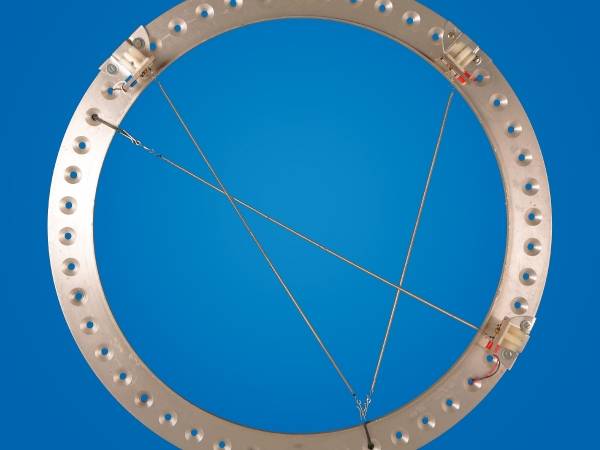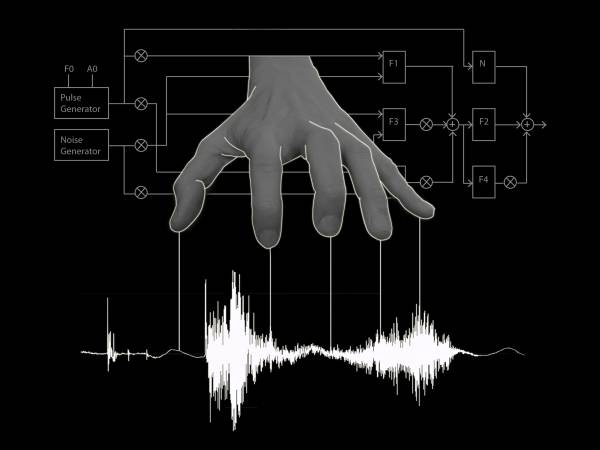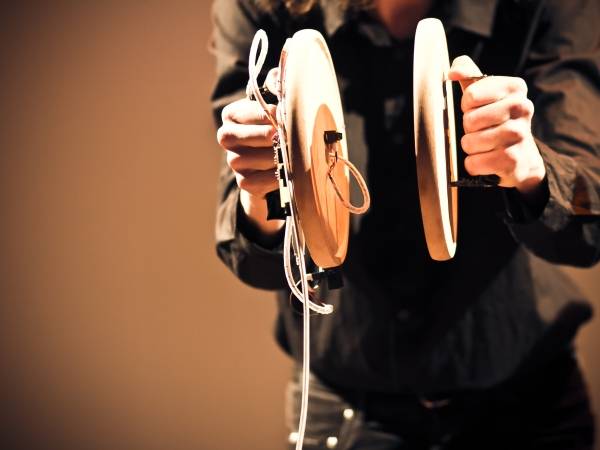19 Minuten
As in the old adage “when you have a hammer everything looks like a nail,” these days it’s easy to assume that any problem, whether aesthetic or technical, can be solved with a computer, especially if you’re a “digital native.” I was not—I had learned computers as a second language, after the technical motherese of circuitry—and I could see that sometimes the computer was preselecting a limited, less-than-optimal set of options where a simpler and more direct tool would open things up.
My students were not unaware of this. Among the most popular offerings of the Sound Department at SAIC were classes in musical instrument building and audio installations. Artists like to make things. But if few of them had any grounding in traditional instrumental music, even fewer knew anything about circuitry. As with hook-writing, they knew there was something missing. More than one asked if the department might offer a class in making electronic music without computers, so in 2002 I designed “Hardware Hacking.”
I saw the course as bridging the gap between the sound world of our thoroughly electronic culture and the timeless tactile habits of the human hand. Reaching back to my earliest forays into electronics, I tried to remember what it was like to be completely incompetent. What kind of advice or information had helped me out of my jams? There was no reason to waste students’ time replicating processes and effects now more easily produced on a computer, but there were sounds and forms they were unlikely to reach through software.
We begin with listening: using speakers, microphones, making contact mics, and experimenting with inductive pickups for eavesdropping on electromagnetic signals emitted by all the electrical devices in our world (as well as natural phenomena like lightning and meteor showers). We pull tape heads out of broken cassette players, solder them directly to audio cables, and swipe them across the magnetic strips on credit cards, playing back their digital data as sound. These non-standard microphones extract unexpected sounds from familiar objects and places and are cheap enough that you can do things with them you wouldn’t attempt with a Neumann. I show examples of what other artists have done with a particular device, then leave it to them to experiment: record a firecracker in a bottle, or a banana in a blender, or a penny being flattened on a railroad track.
Then we play electronic sound, as directly as possible: we lick our fingers and lay them gently on a transistor radio circuit board. Small currents flowing through the skin create feedback paths that push the circuit into oscillation and transform the radio into a touch-sensitive synthesizer, a cheap imitation of the STEIM Cracklebox.
In the mid-1990s, instrument-builder Reed Ghazala began publishing articles in the journal Experimental Musical Instruments on what he dubbed “Circuit Bending”: modifying inexpensive sound-making toys to create performable instruments.1 Repurposing consumer devices had been common practice among experimental musicians since the 1960s, but circuit bending took advantage of the plethora of recent toys containing remarkably advanced sound circuitry, while pointedly abjuring the study of the electronic principles behind them. (David Tudor, by contrast, extended the paltry range of available circuits with a hard-won understanding of what was going on inside each one.) Ghazala advocated what he called “anti-theory”: make new random connections between points on the circuit board, take a photo when you get a cool sound, upload it to the web for others to copy, and don’t worry if you don’t understand it. This dismissal of expertise had obvious appeal among art students who had bypassed science in high school, so I include a session or two of circuit bending. We listen to video signals from cameras and games—low-pitch drones whose overtones shift balance as the image changes—and hack LCD toys to create tiny pixel animations and crude video projectors.
We progress to building circuits from scratch: oscillators, fuzztones, gates, and panners. We cover “glue” circuits: simple mixers and amplifiers that have multiple uses. We wrap up with a ten-step sequencer that has been used for the bass lines in a thousand techno tracks—a gift to those students obsessed with dance music.
The designs I prepared for the class were easy to understand and build, virtually impossible to blow up, and could be assembled like Lego bricks to create complex networks. This process is facilitated by bypassing traditional analog approaches in favor of circuits based on digital CMOS chips, which can run on a 9-volt battery for months and use fewer parts than their analog equivalents (the chance of making a mistake in assembling a circuit is directly proportional to how many pieces you have to stick together.)2 Performability is stressed throughout: the projects make extensive use of photoresistors (devices that change resistance with light level), direct skin contact, pressure pads, and other intuitive interfaces for playing the circuits through physical gestures.
I was guided by five basic goals:
- Keep the students alive. To avoid the experience of the young Michel Waiswisz (who nearly killed himself touching the circuit board of his father's shortwave radio), we use batteries rather than the potentially lethal voltages running through the walls.
- The early stages of unsupervised electronic play activity are thus kept safer and less daunting.
- Keep things simple. We get cool sounds quickly by starting with a small number of axiomatic circuits that can later be combined with permutational richness.
- Keep things cheap. Students don’t need a full electronics lab, just a soldering iron, a few hand tools, and a modest number of parts easily obtained online.
- Keep it stupid. They learn to design by ear, not by gazing at test instruments or engineering texts. The little bits of theory that are introduced arrive only after direct experience.
- Forgive and forget. There is no right way to hack. The circuits we build are robust, tolerant of wiring errors, and accept a wide range of component substitutions. The designs are starting points from which one could go on to create many variations with minimal help or risk.
Some of our projects escaped the classroom and spread through the school like the flu. At the cusp of the 1980s, composer Richard Lerman had discovered that the piezo disc, which had been in use as an inexpensive and energy-efficient speaker for beeping alarm clocks and truck backup warnings, made a wonderful, cheap, loud contact mic. When my class started making piezo disc contact mics, my department’s facilities manager, Robb Drinkwater, coated one in Plasti-Dip, a rubber paint normally used to create soft grips on tool handles. Plasti-Dip protects the delicate soldered connections, improves the sound quality by deadening the resonant peak at the beep frequency, and also waterproofs the mic, effectively creating a one-dollar hydrophone. (I brought home a can of the stuff, and our five-year-old asked if she could dip her toothbrush. I didn’t realize she meant the bristles, but the result was a surrealist object worthy of Méret Oppenheim.) Suddenly, every department seemed to find a need for contact mics—filmmakers used them to record Foley sound effects; performance artists amplified floors; sculptors converted mute objects into sound installations.
Part of the ethos of the hacking class is making maximum use of the minimum of materials, for reasons both economic and ecological, and much of what we do is repurposing found technology. (My early adoption of the KIM and VIM aside, I often approach most technology not at its cutting edge, but at its trailing hilt, adapting it for new use after it has become culturally familiar.) One semester an overstock of “Big Mouth Billy Bass” was being unloaded at the local Walgreens for five dollars each (marked down from forty). Billy was a rubber-skinned mechatronic fish mounted on a fake wood plaque like a trophy. When someone passed by, a motion sensor triggered playback of a few bars of Bobby McFerrin singing “Don’t Worry, Be Happy” or Al Green’s “Take Me to the River,” while the fish flopped its tail and opened and shut its mouth in time to the lyrics. For one season this was deemed hilarious, and it sold like crazy at a premium price. Five years later, five students chipped in a dollar each to buy shares in a remaindered fish. One took the circuit that played the music and hacked the clock to slow down the chipper song to a spooky growl. The second student used the motion sensor to turn on a different bent toy whenever someone came near. The third mounted an oscillator inside the rubber skin, instead of the usual plastic or metal box (Altoid tins were the default housing for many of my students), with a photoresistor embedded in the eye. The fourth built a small keyboard into the woodgrain plaque. The fifth glued an aluminum lampshade to the plastic skeleton and positioned it over a speaker: when the motor flapped the tail, the lampshade moved up and down, filtering the sound like a toilet plunger wah-wah mute on a trumpet.
Italian musicologist Veniero Rizzardi refers to my hacking workshops as quinto quarto or “fifth fourth.” There’s a traditional Roman recipe with that name, he told me, that uses the entrails (tripe, brains, tongue, etc.) left over after an animal carcass has been divided into the quarters that provide the best meat. “Your classes remind me of that dish.”3
Every project is accompanied by examples of what other artists and musicians have created with similar devices. Many of the designs were adapted from the work of my musical colleagues, and are best understood in the context of the music they made with them. So just as students of painting might take a gander at van Gogh if they’re experimenting with impasto, hacking gives insight into music and aesthetics about which most students know nothing. The class perpetuates the craft of handmade electronic instruments while contributing to the ongoing archive of music made with them. By the end, students acquire both technical skills and an appreciation of their aesthetic implications.
There is a beautiful moment, usually around the time a student discovers the ticklish spot that causes a radio circuit to swoop and warble, where euphoric self-confidence sets in. Most leave the class happy and fearless, if a threat to the electronic possessions of their roommates. The syllabus is designed as a roadmap to this euphoria and to suggest that it could have a higher utility in music and art. The students might still go home and assemble sounds on their computers at will, but now they could choose between ultra-processed downloads and chewy whole-grain electronics. Every class seems to have an aspiring techno producer who starts off merely wanting to add something new to her sound palette, only to leave making stranger things and tracking down obscure recordings by someone we had discussed. Although most of the artists whose work I demonstrate are, like myself, from the experimental fringe of the musical spectrum, I try to make the class as tolerant of aesthetic diversity as possible: that techno producer would feel no shame had she limited her semester’s takeaway to new tools for her primary obsession.
The class has been remarkably popular—not just because it was, as Susan put it, “Gameboy for Credit,” but because it offers a hair-of-the-dog remedy for the contemporary world’s digital hangover. A lot of people, it seemed, had woken up in the new millennium with a headache from software overindulgence and a desire for something physical. Hardware hacking was their prairie oyster.
The hacking class handouts eventually grew into a crude PDF handbook that escaped the walls of the school. Emails arrived inviting me to give workshops elsewhere in the United States and around the world. Whereas my SAIC class met once per week, 9 a.m. to 4 p.m., for a full semester, my outside workshops ranged in duration from forty-five-minute sessions I presented for schoolchildren in branches of the Chicago Public Library in the summer of 2011, to residencies of two to five days at maker spaces and academic institutions on multiple continents. Then in 2005, Richard Carlin, the music editor at Routledge, contacted me about doing a proper book. Routledge is an academic publisher, and while I was happy to see the project get better distribution than hand-to-hand PDFs, I had no interest in rewriting everything in proper academic prose.
Hardware Hacking. Workshop, Sound Studies program, Universität der Künste, Berlin, Germany, May 2022.
“We have no problem with your writing style,” Carlin assured me. “But your drawings are terrible.” This is objectively true. He asked if I could find a student to make them more legible, and also suggested adding sidebars to provide more information about the artists and composers mentioned.
Carlin further recommended including a CD of what the finished projects sounded like. (This was 2005, when books with CDs were still a happening thing.) I worried that including audio samples might kill the delight of hearing your own circuit for the first time, so I countered with the offer to gather examples of actual musical works that employed elements similar to those in the text. The sidebars would be no problem, and I hired as an illustrator one of my ex-students, Simon Lonergan, who had worked for a T-shirt company converting photos of hot rods into high high-contrast silkscreen stencils— roughly equivalent to translating schematics and photos of rat-nest wiring into legible figures. (I can only assume that when peers familiar with my original PDF expressed dismay at my drawings’ replacement in the published book there was some sarcasm involved.) He was also a good commercial photographer and could document objects and instruments. The result was Handmade Electronic Music—The Art of Hardware Hacking, published in 2006.4
Much of the book was written at 35,000 feet above oceans between workshops and concerts. For all the discomfort of long-haul flying in economy class, I found the disconnect from daily life inspirational. I considered crediting United Airlines in my acknowledgments until I totted up the money I’d paid for tickets as an unofficial Writer-in-Residence, which amounted to thanks sufficient.
The book was published amid yet another round of hysteria over “the death of the printed book.” But as someone who had struggled to distribute independent records (selling out of my suitcase on tour, giving away promo copies, a tiny number of store and mail-order sales), I was amazed by the reach of a book from a reputable publisher. It was available internationally through web retailers (mostly Amazon) who never handled my records, and modest royalties arrived steadily. For many years, it was Routledge’s top-selling title outside the United States, perhaps as a result of its simple prose and profuse illustrations—a graphic novel among the dense thickets of critical theory that populate Routledge’s roster. While marketed as a textbook, it was equally (if not more) popular as a how-to guide for the distinctly non-academic hacker.
I had thought that with the book now widely available, invitations to conduct workshops would decrease, but the reverse happened. People could now study and build the projects on their own, but they preferred doing it in groups, and my presence was a convenient catalyst for people to come together in a particular place at a particular time. The term DIY (Do It Yourself) had long been applied to the “maker” movement, but the workshops were DIT (Do It Together), and this represented a significant shift in the way they were valued: not just as a way to learn a skill, but as a way to build or strengthen community.5
As time went by and I ran hacking workshops in a wider range of venues, the depth and contours of the rift between the worlds of software and hardware became increasingly apparent. In 2004, I presented one at the brand-new Sonic Arts Research Center (SARC) at Queen’s University in Belfast, Northern Ireland. The participants included faculty and staff, along with doctoral students in electronic and acoustical engineering, composition, and computer science. Midway through the second day, I noticed that one guy seemed completely clueless. Anything that could be done wrong, he did wrong: his chips were installed backward, his battery polarity was reversed, and so on.
“Are you by any chance a composer?” I probed gently, since I’d found that composers often have poorer manual skills than visual artists.
“Oh no,” he answered cheerfully, “I’m an electronic engineer.”
I was dumbstruck.
He went on: “I got my BSEE last spring and I designed a Digital Signal Processor chip for my senior project. But we did everything in CAD [computer-aided design] software. This is the first time I’ve actually touched a component or a soldering iron.”
SARC was planned as a very high-tech facility, the UK’s answer to IRCAM. I was presenting material from the opposite, feral end of the technological spectrum, which had a mysterious appeal. One student raised his head from circuit rapture and turned to the center’s director to ask, “So what the fook did we buy all those computers for?”
In every workshop I am called upon to debug recalcitrant circuits by novice hackers. I circulate around the room like the grandmaster in old photographs playing a dozen kids at a chess club, walking from one table to the next, inspecting the boards, making moves, holding all those games in his head. Toward the end of a workshop in Vienna in 2010, a student called my attention to a circuit and explained, “It only works when I breathe on it.” She blew gently, and indeed an oscillator sprang to burbling life but then, over the course of ten seconds, sputtered and went silent. Turning the board over, I discovered a tiny crack between a blob of solder, the leg of a chip, and the copper trace on the circuit board. The moisture of breath was sufficient to bridge the gap, but as the flow of current heated the water, it would evaporate, breaking the connection again. The problem could be eliminated with a fresh drop of solder, but appreciating the peculiar breath-of-life quality of her circuit, she opted to keep it in its poetic state and built a second, “normal” version in the day’s remaining hours.
Workshops begat other workshops. People who participated in one went on to organize others elsewhere. Alejandra Perez Nuñez, a Chilean artist studying in Rotterdam, attended a workshop in Brussels in 2004. After returning home to Valparaíso, she loaned her early PDF version of the hacking book to Fernando Godoy, a local musician and concert producer, who set up a modest business buying parts in quantity for the projects and distributing them to local hackers by bicycle (no mean feat in so hilly a city). In 2011, Fernando—unaware that my mother had grown up a few miles away in Viña del Mar—invited me to present a workshop and concert in the Tsonami festival.
The book spread like a virus. Against all reasonable expectations, Handmade Electronic Music has had a profound impact on how electronic music is made and thought about. I have given more than 200 workshops and classes in hardware hacking to some 3,000 participants. They have taken place on every continent except Antarctica (though the Cielo de Infinitos festival in Punta Arenas, Chile, “The southernmost arts festival in the world,” did get me within 900 miles). And while I am still invited to give workshops in person, the book has traveled even further without me. People I’ve never met are reading it and conducting their own workshops, from Trondheim to Jakarta.
Everywhere I go, I now encounter what I call “elemental electronic music,” with similar background stories: boy/girl buys a guitar/bass/keyboard and forms a band with friends. They can’t play very well, so they buy a pedal that makes things sound better. They buy another pedal to sound even better. And another. Soon they are spending more time experimenting with pedals than playing their instruments. They build a contact mic and discover that the pedals sound just as interesting with a contact mic instead of the guitar/bass/keyboard. Then they come to a fork in the road: they either get brave enough to open up the pedals and play the circuit boards with their fingers, or they abandon their pedals and play just the contact mic. The greatest exuberance in the workshops often accompanies the most fundamental projects: making an oscillator out of nothing more than a speaker and a battery; recreating the lightsaber sound effect from Star Wars with a freshly soldered contact mic and a Slinky; passing a coil pickup over a cell phone to reveal the inner voices of the circuitry.
But the workshops do something still more powerful, something that stretches beyond the fun of boops and beeps. Again and again, I hear from participants that the great takeaway was not any specific circuit, but a sense of empowerment, of exerting control over technology that is widely used, but seldom understood in its material specificity. After a couple of days with an eviscerated toy and a soldering iron, the ubiquitous label “no user-serviceable parts inside” ceases to be a prohibition and instead becomes a challenge. It is often difficult in an art school to gauge the long-term benefits of classroom teaching, but the impact of the hacking curriculum has been profound.
That said, my children’s attitude toward my profession has fluctuated over the years. The eldest, surveying a glitchy circuit of mine with the gimlet eye of a middle-schooler, pronounced: “In this world there are Makers and there are Breakers. Steve Jobs is a Maker. Dad, you are a Breaker.” A few years later, however, when we were depositing this same child in his dorm, a curious fellow student picked up a recently unpacked object on the dresser.
“What’s this?”
“It’s a Scratchmaster. My dad made it. It lets you hear the sounds of the magnetic stripes on credit cards and IDs.” The kid ran his school ID through, eliciting a sound similar to scratching a record. They were still scratching away when we left. To break the ice, it can help to know a Breaker.
The intergenerational benefits have been reciprocated. In elementary and middle school, our youngest would periodically spend an afternoon with friends making a movie. They would write a script, design costumes, shoot, edit, and upload to YouTube by dinner time. The results were rarely longer than a minute and always contained a dizzying number of cuts. I had sat on grants panels where we reviewed artists’ videos, and I commented that one minute into those tapes we would still be looking at color bars, waiting for the action to begin. “No video needs to be longer than a minute,” came her stern response.
When I was called upon to assemble a DVD for the second edition of Handmade Electronic Music (replacing the first edition’s CD), I heeded this advice and circulated a call for video contributions with a one-minute cap. The DVD also included thirteen largely improvised tutorials, a cross between my typical workshop banter and the late-night televised “open universities” that bring education to insomniacs around the world. Reviewing the book in The Wire, a UK music magazine, Chris Sharp described the DVD as “surprisingly watchable.”6 You can’t buy press like that.
This article is an excerpt from the book "Semi-Conducting - Rambles Through the Post-Cagean Thicket" by Nicolas Collins (2025). Courtesy of Bloomsbury Publishing Inc.
- 1
https://barthopkin.com/experimental-musical-instruments-back-issues/ (accessed August 31,2022). For more on Reed Ghazala, see http://www.anti-theory.com/bio/ (accessed August 31, 2022). Also Reed Ghazala, Circuit-Bending: Build YourOwn Alien Instruments (Wiley, 2005).
- 2
CMOS (complementary metal-oxide-semiconductor) refers to a fabrication process for integrated circuits that came into prominence in the 1970s in the design of digital chips. This technology was used not only in early microprocessors like that in the KIM-1 computer but also in smaller integrated circuits that performed discrete logical operations (AND, OR, NOT, etc.), such as those I describe in earlier chapters. They were popular among my circuit-building peers in the 1970s because they were cheap, consumed very little power, and could be tricked into performing functions normally associated with more complicated analog designs.
- 3
Conversation with Veniero Rizzardi, 2008.
- 4
Nicolas Collins, Handmade Electronic Music—The Art of Hardware Hacking (Routledge, New York and London, 2006. Expanded2nd edition (with DVD), 2009. Expanded 3rd edition (with website and thirty contributing authors), 2021). Translations have been published in Japanese (O’Reilly, 2013) and Korean (Hanbit Media, 2016). You can find the original PDF version I created for my students, in all its scribbly glory, here: http://www.nicolascollins.com/texts/originalhackingmanual.pdf
- 5
When the third edition of Handmade Electronic Music was published in 2020, I expanded it to include new chapters by thirty younger authors. Several of these contributions cover aesthetic and historical aspects of hacking culture rather than technical instruction, and two of them focus specifically on the development of DIT movements worldwide.
- 6
Chris Sharp, “Handmade Electronic Music: The Artof Hardware Hacking,” (review) The Wire, No. 207 (September 2009): p. 70.
Nicolas Collins
New York born and raised, Nicolas Collins spent most of the 1990s in Europe, where he was the Artistic Director of STEIM (Amsterdam), and a DAAD composer-in-residence in Berlin. For many years he was a Professor in the Department of Sound at the School of the Art Institute of Chicago and Editor-in-Chief of the Leonardo Music Journal, and is currently a Research Fellow at the Orpheus Institute (Ghent). An early adopter of microcomputers for live performance, Collins also makes use of homemade electronic circuitry and conventional acoustic instruments. His book, Handmade Electronic Music – The Art of Hardware Hacking (Routledge), now in its third edition, has influenced emerging electronic music worldwide. His memoir, Semi-Conducting- Rambles Through the Post-Cagean Thicket, was released by Bloomsbury in 2025.
Article topics
Article translations are machine translated and proofread.
Artikel von Nicolas Collins
 Nicolas Collins
Nicolas Collins 